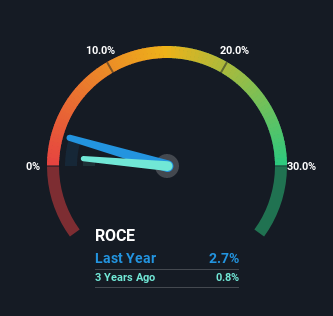- Serbia
- /
- Construction
- /
- BELEX:ENHL
Energoprojekt Holding a.d's (BELEX:ENHL) Returns On Capital Not Reflecting Well On The Business
If we're looking to avoid a business that is in decline, what are the trends that can warn us ahead of time? A business that's potentially in decline often shows two trends, a return on capital employed (ROCE) that's declining, and a base of capital employed that's also declining. This reveals that the company isn't compounding shareholder wealth because returns are falling and its net asset base is shrinking. So after we looked into Energoprojekt Holding a.d (BELEX:ENHL), the trends above didn't look too great.
Understanding Return On Capital Employed (ROCE)
For those that aren't sure what ROCE is, it measures the amount of pre-tax profits a company can generate from the capital employed in its business. To calculate this metric for Energoprojekt Holding a.d, this is the formula:
Return on Capital Employed = Earnings Before Interest and Tax (EBIT) ÷ (Total Assets - Current Liabilities)
0.027 = дин703m ÷ (дин37b - дин11b) (Based on the trailing twelve months to June 2022).
So, Energoprojekt Holding a.d has an ROCE of 2.7%. Ultimately, that's a low return and it under-performs the Industrials industry average of 8.6%.
View our latest analysis for Energoprojekt Holding a.d

While the past is not representative of the future, it can be helpful to know how a company has performed historically, which is why we have this chart above. If you're interested in investigating Energoprojekt Holding a.d's past further, check out this free graph of past earnings, revenue and cash flow.
How Are Returns Trending?
We are a bit worried about the trend of returns on capital at Energoprojekt Holding a.d. Unfortunately the returns on capital have diminished from the 5.1% that they were earning five years ago. And on the capital employed front, the business is utilizing roughly the same amount of capital as it was back then. Companies that exhibit these attributes tend to not be shrinking, but they can be mature and facing pressure on their margins from competition. So because these trends aren't typically conducive to creating a multi-bagger, we wouldn't hold our breath on Energoprojekt Holding a.d becoming one if things continue as they have.
On a side note, Energoprojekt Holding a.d has done well to pay down its current liabilities to 29% of total assets. That could partly explain why the ROCE has dropped. What's more, this can reduce some aspects of risk to the business because now the company's suppliers or short-term creditors are funding less of its operations. Since the business is basically funding more of its operations with it's own money, you could argue this has made the business less efficient at generating ROCE.
The Bottom Line On Energoprojekt Holding a.d's ROCE
In summary, it's unfortunate that Energoprojekt Holding a.d is generating lower returns from the same amount of capital. Investors haven't taken kindly to these developments, since the stock has declined 69% from where it was five years ago. With underlying trends that aren't great in these areas, we'd consider looking elsewhere.
Energoprojekt Holding a.d does come with some risks though, we found 3 warning signs in our investment analysis, and 1 of those doesn't sit too well with us...
While Energoprojekt Holding a.d may not currently earn the highest returns, we've compiled a list of companies that currently earn more than 25% return on equity. Check out this free list here.
Valuation is complex, but we're here to simplify it.
Discover if Energoprojekt Holding a.d might be undervalued or overvalued with our detailed analysis, featuring fair value estimates, potential risks, dividends, insider trades, and its financial condition.
Access Free AnalysisHave feedback on this article? Concerned about the content? Get in touch with us directly. Alternatively, email editorial-team (at) simplywallst.com.
This article by Simply Wall St is general in nature. We provide commentary based on historical data and analyst forecasts only using an unbiased methodology and our articles are not intended to be financial advice. It does not constitute a recommendation to buy or sell any stock, and does not take account of your objectives, or your financial situation. We aim to bring you long-term focused analysis driven by fundamental data. Note that our analysis may not factor in the latest price-sensitive company announcements or qualitative material. Simply Wall St has no position in any stocks mentioned.
About BELEX:ENHL
Energoprojekt Holding a.d
Operates as a design, consulting, engineering, and construction company in Serbia and internationally.
Solid track record with excellent balance sheet.
Market Insights
Community Narratives



